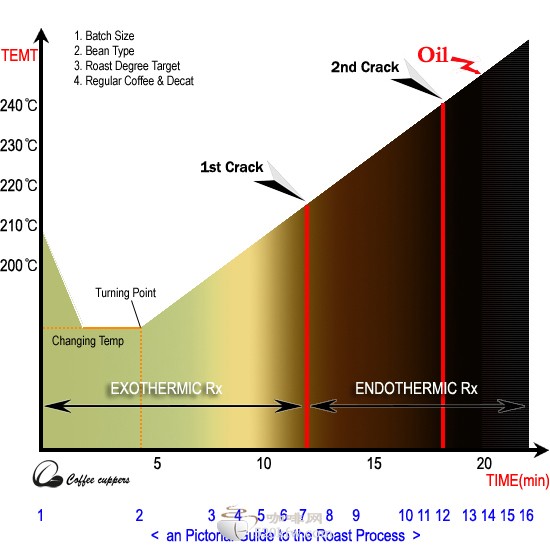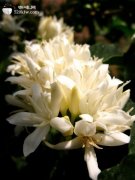Analysis of roasting process of Coffee
Coffee roasting (coffee roasting) refers to the heating of raw beans to convert starch in raw beans into sugars and acids at high temperature, cellulose and other substances will be carbonized to varying degrees, water and carbon dioxide will be volatilized, protein will be converted into enzymes and fats, and the remaining substances will be combined to form an oil film on the surface of coffee beans, and in this process will produce sour, bitter, sweet and other flavors of coffee. The process by which raw beans are converted into dark brown beans by forming a mellow degree and hue. Because a variety of small changes in temperature, heat and other small changes in the baking process can change the taste of beans, different beans have different characteristics, and baking is a fast operation in a short time, so it is required to accurately budget the baking process and adjust it timely.

The reactions and changes that occur during coffee roasting can be summarized as follows:
1) dry. When the raw coffee beans are heated, the water vapor in the raw beans begins to evaporate. when the temperature is about 135℃, the color of the raw beans begins to change, starting to turn white from green.
2) dehydration. Continue to heat, raw beans from green to light yellow, when the temperature reaches 160℃ or so, will emit the aroma of baked grain, continuous heating, beans become light brown.
3) an explosion. When the temperature is about 190℃, after the dehydration is completed, because the coffee bean is expanded by heat until it breaks into an explosion, a series of thermal decomposition reactions will take place inside the bean, in which the caramelization reaction will bring the sweetness, dark brown and mellowness of the coffee bean, and the explosion will last about 1.5 minutes.
4) second explosion. Continue to heat, into the second explosion, when the beans will have a more violent reaction, and release a lot of heat. With the end of the second explosion, the raw bean has basically turned black, the bean body has expanded to 1.5 times that of the original, the surface is oily, and the weight has been reduced by 12% to 20%. Usually the roasting of coffee beans ends about a minute after the end of the second waterfall at the latest.
Important Notice :
前街咖啡 FrontStreet Coffee has moved to new addredd:
FrontStreet Coffee Address: 315,Donghua East Road,GuangZhou
Tel:020 38364473
- Prev

Use "red, yellow and green" to interpret caffeine content for you.
Want to know how much caffeine is in your coffee? Caffeine Orange will help you solve this problem. It is reported that Caffeine Orange is a tool to detect caffeine. The user drops a little of the coffee liquid to be tested into a groove in the test plate and shakes it. The researchers are trying to make it possible for ordinary people to use this.
- Next

Complete answer to Blue Mountain Coffee knowledge
Jamaica, the origin of Blue Mountain Coffee, gets its name from the Blue Mountains surrounded by the Caribbean Sea. Sour, sweet, bitter taste are very harmonious and have excellent flavor and aroma, suitable for individual coffee, suitable for moderate roasting.
Related
- Beginners will see the "Coffee pull flower" guide!
- What is the difference between ice blog purified milk and ordinary milk coffee?
- Why is the Philippines the largest producer of crops in Liberia?
- For coffee extraction, should the fine powder be retained?
- How does extracted espresso fill pressed powder? How much strength does it take to press the powder?
- How to make jasmine cold extract coffee? Is the jasmine + latte good?
- Will this little toy really make the coffee taste better? How does Lily Drip affect coffee extraction?
- Will the action of slapping the filter cup also affect coffee extraction?
- What's the difference between powder-to-water ratio and powder-to-liquid ratio?
- What is the Ethiopian local species? What does it have to do with Heirloom native species?

